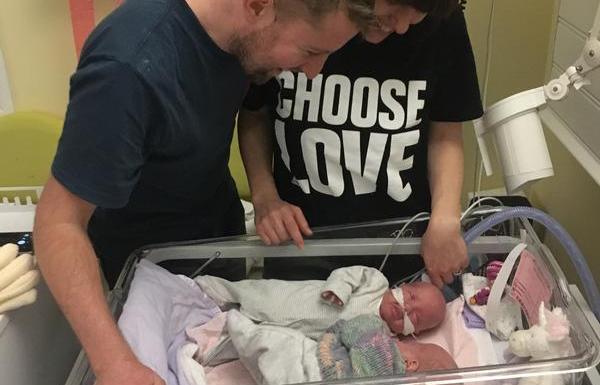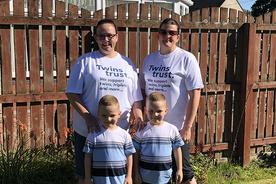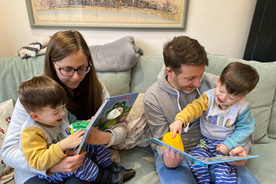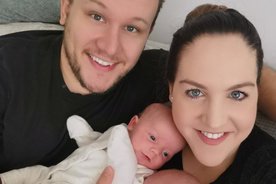7 December 2018
Bryony and Tom had been trying to have a baby for three years. After three rounds of IVF, Bryony was diagnosed with low ovarian reserve and would need a donor egg.
“Waiting for a match and ultimately that positive pregnancy test was an emotional rollercoaster, but little did I realise that it was good training for what was in store for us,” said Bryony.
Scanned early, the couple were thrilled that the one egg implanted had divided creating identical twins – two miracle babies!
But at just 16+4 weeks Bryony was diagnosed with Stage 3 TTTS after the sonographer detected a 20% size difference between the babies, uneven fluid levels, and the beginnings of reverse blood flow in the recipient twin.
TTTS is a condition whereby one twin transfuses blood to the other whilst in the womb, leaving one with too little and the other with too much.
The couple had read about TTTS via a Twins Trust leaflet and discovered that the Fetal Medicine Centre was a short walk from their London home and one of only six hospitals in the UK that treat TTTS.
The diagnosis was so severe that Bryony wasn’t allowed home after the scan and a few hours later had laser ablation surgery otherwise it was expected that both babies would die in a matter of days.
Laser ablation is where every blood vessel connecting the twins are closed to prevent the flow of blood from one baby to another and the possible risk of transfusion. It is generally considered to be the most effective treatment for TTTS.
Bryony said:
It all felt surreal, like a dream. The babies we’d come to love were possibly going to be taken from us.
Bryony then experienced heavy blood loss. A scan soon after revealed two strong heartbeats, but it also showed the gestational sac had come away from her uterus wall. The prognosis was a miscarriage.
The couple were sent home to wait and a few hours later Bryony lost a lot of amniotic fluid. With hope fading they rushed back to hospital – both babies were still alive, but the outlook was grim.
Now both babies had little to no fluid around them. After 48 hours Bryony was again sent home and told to wait feeling it was incredibly unlikely that she’d make it to viability at 24 weeks.
“I stayed at home and didn’t allow myself to think ahead, to buy baby things, think of names, or any of the other normal things you would do to plan for a new baby,” she said.
The only thing that got me through was feeling the girls moving inside me and being grateful for the present moment. Think any further ahead, and I’d get scared.
Weekly scans revealed that the growth disparity between the girls was stabilising, which was encouraging, but the recipient twin’s sac never resealed, although showed some fluid around her.
Bryony was told that if her recipient twin survived at all, her lungs would be seriously compromised.
It was at 26+6 weeks when Bryony got an infection that triggered labour.
“We didn’t know what the outcome would be, but we were prepared to expect our recipient twin not to survive,” said Bryony.

“She was born first, weighing 820g, and I knew she couldn’t have been too sick because I was allowed to touch her head before she was intubated.
“Our other twin was born two minutes later, weighing 864g, and she cried out – I was in shock! After touching her head as well, she too was intubated and they were taken away in incubators up to the Neonatal Intensive Care Unit (NICU). They were so fragile and beautiful to me, but I knew to anyone else, they would appear shocking to look at.
“We were so grateful that the staff had taken the time to show us around the NICU beforehand as it helped us know what to expect. We were yet more grateful the girls were alive and every minute we had with them we cherished and named them Frida and Pia.
“We visited the NICU daily for five and a half months. The hardest days were early on when Frida was so poorly her emergency chord was pulled several times. We are incredibly lucky, as we know many other parents who walked out of hospital empty handed.
“Having the girls in hospital was the most difficult time in our lives. Pia was in hospital for two and a half months and was discharged two weeks before her due date without any medical needs.
“Frida showed us her resilience being in hospital for five and a half months, but she made it home with oxygen and a feeding tube.
“Now at just over one-year-old Frida no longer has any medical needs and both girls seem to be hitting their milestones. We can’t quite believe it! They are amazing and our hearts have never been so filled with love.
“We are forever indebted to our friends and family who supported us through this journey; to the Fetal Medicine Centre and King’s College Hospital staff; to Twins Trust for their support and to Frida and Pia who have taught us so much.
“We hope our story can raise awareness of TTTS and give encouragement to those families suffering with the syndrome right now.
“Where there’s a heartbeat, there’s hope.”
-strap.svg)



